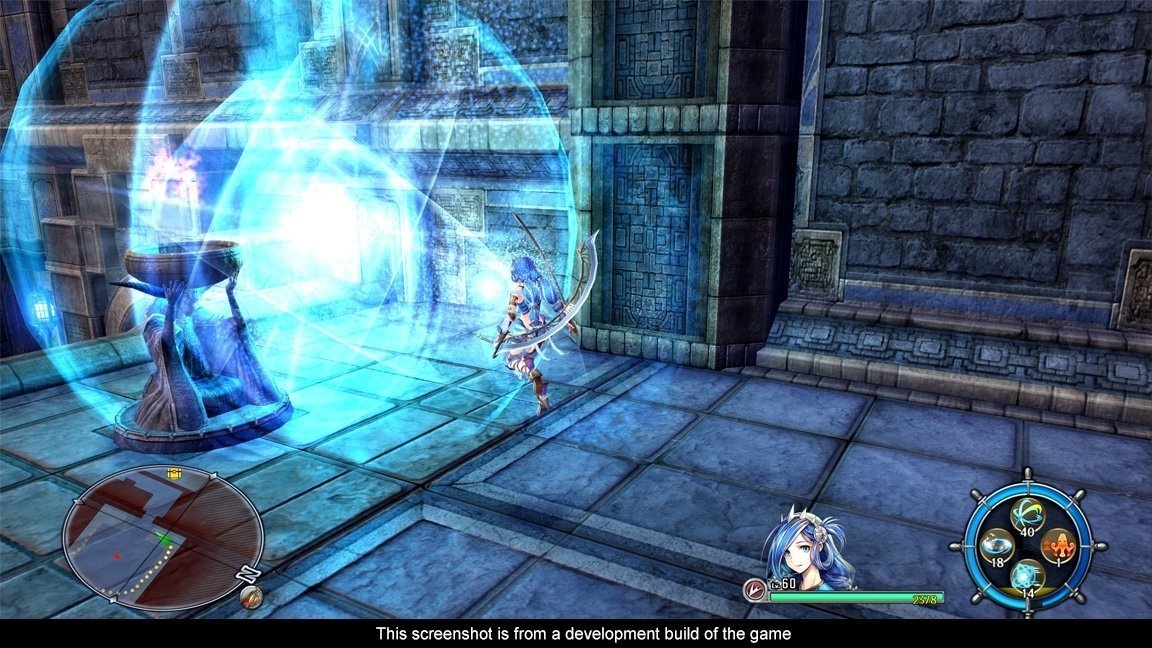Ys VIII: Lacrimosa of Dana (PlayStation 4) Review
By Renan Fontes  29.08.2017
29.08.2017

Over countless iterations and thirty years' worth of instalments, Ys has known one constant: adventure. From bumper car combat, to hack n' slash action, and now a party-based JRPG, Adol Christin's life never strayed too far from exploring a new land and leaving a mark on the world. Ys VIII: Lacrimosa of Dana is the first all-new title in eight years, taking Adol to a never before seen or mentioned land: Seiren Island. As another interquel, it can be easy to write off the story as just a gap filler, but what it does for the series is astronomical. In terms of story and gameplay, Ys VIII is a leap forward that captures that spirit of adventure better than everything that came before it.
At first glance, Ys VIII's story comes off filler-esque in the grand scheme of Adol's life. The series has made a point of following his exploits in discovering the new world, and having him stranded on a deserted island seems counterintuitive to the franchise's grand narrative. It doesn't take long to realize why exactly Falcom chose to shipwreck Adol, however.
In capsizing Adol's vessel, he and roughly 25 passengers are trapped on an island that's as foreign to them as it is to the known world. Here, the narrative can be isolated and focus on exploring a cast separated from civilization. In this separation, Falcom can justifiably experiment with ignoring genre conventions: there is no currency, there are no towns, and near every inch of Seiren Island is hostile territory.
Seiren Island is not just teeming with countless gameplay possibilities; it's also home to what can only be considered the most substantial lore the series has seen in years. In terms of story, Lacrimosa of Dana might wind up one of the most important pieces in Ys' ever growing puzzle.
Introduced to the universe are gunpowder, the theory of evolution, and "Ancient Species," which serve as the series' dinosaur equivalent. Humanity's purpose is also given considerable attention, which ties into the main theme of the narrative: solidarity.
Ys Seven and Memories of Celceta both focused on rather typical JRPG themes. The former was able to turn its focus on fate into something memorable and subversive, while the latter had trouble playing with the concept of remembrance in a novel way. Lacrimosa of Dana goes in a completely different direction by abandoning traditional RPG themes in favour of something more human and universal.
Survival through solidarity is a theme that can be explored in any medium, yet it shines most where it's least expected. In telling a tale of togetherness in video game format in a genre designed around building a character, that togetherness can be felt first-hand.

NPCs develop through side quests that Adol can initiate and, through these side quests, their arcs grow and their in-game utility improves, whether that be offering new goods to be crafted and traded, or simply offering combat benefits.
Solidarity transcends the clichéd "power of friendship" often found in anime and it should not be confused for it in this instance. The castaways are not friends - not at first, at least. Their interactions and relationships are organic and realistic. Not everyone gets along, not everyone gets to survive, and not everyone is willing to do their share.
The memory framing from Celceta returns with a second chance to shine, where, instead of remembering his own memories, Adol remembers that of co-protagonist Dana's. These segments are, at first, presented as hand drawn paintings where Adol witnesses key moments in Dana's life before transitioning into fully playable section where he shares in Dana's experiences through a shared consciousness.
Multiple protagonists aren't a new concept for Ys, but there has never been an instance where Adol shared his role as lead. Origin outright omitted him to circumvent this, and the other party based entries always kept him at the front of the plot. Here, however, Dana drives most of the plot independent of Adol, and the story is better for it.
Adol's story is defined by a growing unity amongst the castaways, while Dana's places emphasis on losing sight of that unity. This is best seen in how both sections play out. Adol travels with a party and his gameplay will always have three interchangeable character on screen at once, while Dana is exclusively solo from start to finish.
Not only is this an excellent example of exploring themes through gameplay, it's an ingenious way of satiating old and modern Ys fans alike. Adol's section is representative of the how the series has evolved: he has a customizable party, a map that he needs to fill out through cartography, and a wide array of equipment to choose from.

Returning from the previous two entries are Flash Move and Flash Guard; a last minute dodge and block, respectively. Flash Move triggers a bullet time sequence where Adol or Dana can rapidly attack enemies, while Flash Guard turns all attacks into critical hits for a brief period of time. Through careful timing, both of them can be triggered together for double effectiveness.
Despite Adol and Dana both sharing the Flash counters, it's much easier for Adol to make use of them thanks to his full party. Each member of Adol's party controls differently and some are easier to pull off Moves and Guards with. On the fly party switching also allows Adol's group to utilize type advantages - another returning feature.
Types are broken down into three categories: slash, strike, and pierce. Certain enemies are weak to certain types, so constant party switching is encouraged. Unlike Ys Seven, where party switching was effectively mandatory, it's possible to coast by with just one character. Enemies will naturally take more time to kill, but never to any extreme measures.
Dana's section, on the other hand, has her alone, in one expanding dungeon à la Ys Origin, and exploring an already mapped country with quests that are found along the way instead of gathered from a central hub. That's not to say that Dana isn't without her own unique quirks. To compensate for her solo adventure, she has access to a style switcher that allows her to alternate her attack type. All these styles play differently, have different speeds, and serve their own out of combat purposes.
It is worth mentioning that Dana's half does resemble that of a traditional JRPG, with towns and a universal system of currency, but it's used more as a way to show the contrast between her and Adol's adventures. Her setting is populated, but there's an isolating atmosphere. On the other hand, Seiren Island has been deserted for centuries, yet feels very much alive thanks to gorgeous visual, unique enemy designs, and plenty of landmarks to discover.
Throughout Adol's journey, he'll often have to traverse the island in search of other castaways. Each time a new person is found, they're integrated into the makeshift Castaway Village - a haven away from the dangers of Seiren Island. Most NPCs will offer their skills to help Adol on his quest. Soon enough, Adol is able to tailor outfits, craft armour, trade goods, and synthesize new weapons.
Along with character levelling, skills can be learned and levelled for better bonuses. The SP cost stays static without any SP cutting accessories, but raising a skill up to a reliable powerhouse is a great way to incentivize frequent and varied use. Having access to four skills at once also allows for advances combos. With the right timing, it's possible to juggle some of the heftier enemies.
Like any Ys, Lacrimosa of Dana is at its best when Adol is pit against a boss. Boss fights remain as tense as ever, especially in the later half when their sheer size and ferocity begin to overwhelm unrefined playstyles. They're often the best part of every dungeon.
Dungeons themselves are incredibly satisfying to traverse and explore. Seiren Island's set pieces allow for creative level design grounded in a tropical, almost Aztec aesthetic foreign to the rest of the series. Like with the overworld, dungeons feature roadblocks that can be cleared out when the right amount of villagers are living in Castaway Island.
In the overworld, most roadblocks act as progression checks while they serve as gateways to optional content inside of dungeons. On occasion, some overworld roadblocks will lead to high-level bonus dungeons independent from the main quest line.
Ys VIII's only substantial flaw is, disappointingly, not its fault, but that of NIS America. The translation is fine for the most part, but there are several instances where the localization clearly needed another edit. The most glaring example is the use of "you guys" instead of the plural "you." The usage of "guys" is seldom appropriate in context, especially during Dana's gameplay sections in Ancient Eternia.

Credit where credit is due, though; NIS does do a great job localizing the cast. Seiren Island's castaways are all distinct from one another, and they come off as dynamic characters, rather than just NPCs. While the localization quality is nowhere close to XSEED's, there are only a few kinks NIS America needs to iron out should they proceed as the series' overseas publisher and translator.
Adol's characterization stands out especially. Visually, this is the most expressive he's ever been. What he lacks in formal dialogue, he makes up with a gaze that showcases wisdom beyond his years. The few times he does get to speak, his lines are given a careful consideration to what he's been through and flow naturally. He may be a silent protagonist, but he is very much his own individual.
No moment shows this better than the opening. Before any story begins, a text crawl transcribing one of Adol's many future memoirs plays out in which he reflects on the impact Dana left on him. Memories of Celceta opens with a similar moment, but it is nowhere near as sombre as it is here. It is Adol's melancholy writing that sets the stage for not just an emotional journey, but Dana's entire character.
It's no coincidence that the most important women in Adol's life all have blue hair; from the Twin Goddesses, to Tia, and now Dana. Her arc is one rich with pathos, as she struggles with being the matriarchal figurehead of her culture. She's a free spirit and an adventurer at heart, but, unlike Adol, she's held responsible for an entire civilization. At her core, Dana is Adol's foil. While not literally, her character is divine in nature, and it's her struggle between adventure and responsibility that develop Adol into the man who opens the entire adventure.
Any great adventure will impart a yearning for more; more story, more gameplay. While it may not quench that narrative thirst, Lacrimosa of Dana's New Game Plus stands out as one of the greatest interpretations of the mechanic.
The feature adds super dungeons for Adol to tackle, the ability to change every character's attack type for full party customization, and total party management where Adol's party can be cut down from three, to two, to just one active member. On top of all the bonuses, there are no inherent carryovers. Stats, items, and map completion can all be toggled with before New Game Plus begins, making fresh replays just as possible as overpowered ones. It's a level of customization that makes replaying an already excellent game all the more exciting.

Cubed3 Rating
Exceptional - Gold Award

Ys VIII: Lacrimosa of Dana is everything an action RPG could and should be. Genre conventions and traditions are still in play, but they're handled with a delicacy that elevates what would otherwise be tired clichés into imaginative story beats. The narrative is as rich in thematic substance as it is in genuine human interaction, as every NPC is given ample time to grow, while solidarity is emphasized as humanity's best bet at surviving. Lacrimosa of Dana plays like an ideal marriage between Seven and Memories of Celceta, with an equal balance of character building, fast-paced combat, and exploration. NIS America's localization could have used another draft, but it's offset by the franchise's single best story and a host of content to uncover in the base game, along with New Game Plus. Innovative with just enough familiarity, Ys has never been better.

![]() 9/10
9/10
![]() 0
(0 Votes)
0
(0 Votes)
 Out now
Out now  Out now
Out now  Out now
Out now  Out now
Out now Comments
Comments are currently disabled

 Sign In
Sign In Game Details
Game Details Subscribe to this topic
Subscribe to this topic Features
Features





 Top
Top

